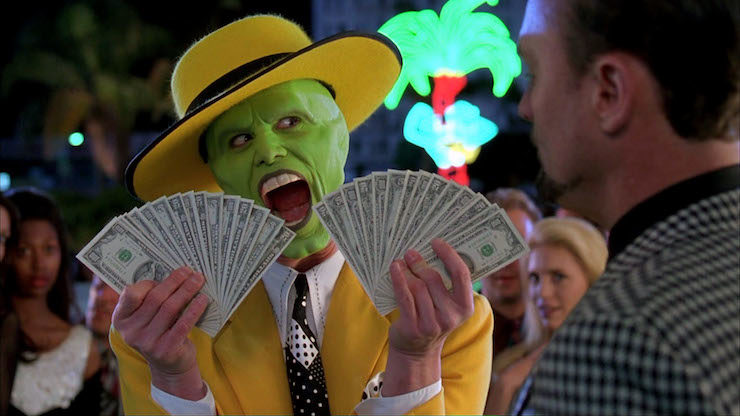The Mask started out as a concept Mike Richardson came up with for a sketch in APA-5, an amateur press fanzine Richardson was involved with in 1985. Later on, Richardson formed Dark Horse Comics, and gave the concept to Mark Badger, who did a feature called The Masque in the anthology comic Dark Horse Presents. The more familiar version—with the big green head, the massive teeth, and the general mode of chaos—debuted in Mayhem in 1989, eventually getting his own four-issue miniseries, the first of several, in 1991, which continued throughout the 1990s.
They were popular enough to become part of Dark Horse Entertainment’s stable of films, for which it was one of their biggest hits.
It helped that The Mask starred Jim Carrey at the height of his popularity. Starting out as a standup comic, Carrey’s breakout was on the Wayans brothers’ groundbreaking sketch comedy show In Living Color. 1994 was the year he officially became a movie star, as he had three hits over the course of the calendar year—The Mask, Dumb and Dumber, and Ace Ventura: Pet Detective. On top of that, the movie launched the acting career of model Cameron Diaz.
An animated series based on the movie (albeit with some changes) debuted the following year, starring Rob Paulsen in the title role. It lasted for three seasons on CBS and the Cartoon Network.
However, it took until 2005 for a sequel to happen. One was planned with Carrey, but after doing Ace Ventura: When Nature Calls, he decided that doing sequels was a bad idea. He declined the offer to do The Mask II, despite director Chuck Russell’s interest in a sequel, and despite Nintendo Power magazine running a contest for a reader to have a walk-on in that sequel. The “winner” of the contest wound up with a cash settlement and an apology.
The sequel was finally made eleven years later starring Jaime Kennedy, with Ben Stein’s Professor Neuman being the only character common to both. Where The Mask was one of the most successful comic book movies of its era, Son of the Mask, er, wasn’t.
“No, those pajamas are impossible—this really happened.”
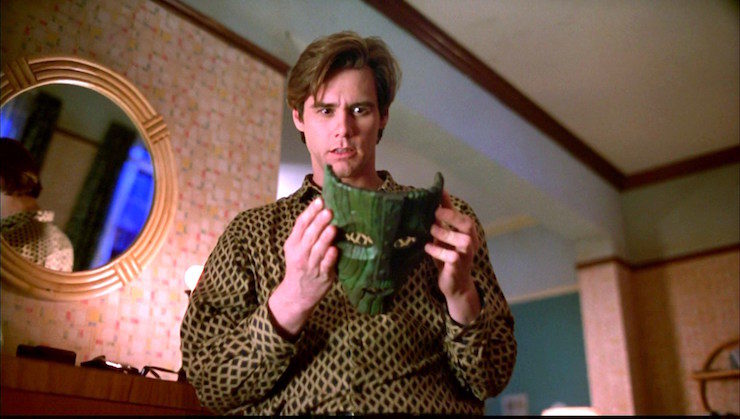
The Mask
Written by Michael Fallon and Mark Verheiden and Mike Webb
Directed by Charles Russell
Produced by Bob Engleman
Original release date: July 29, 1994
A diver off the coast of Edge City finds a literal treasure chest, but a pipe from a nearby boat comes loose and pins the diver right after he breaks into the chained and locked chest. The contents of the chest consist solely of a green wooden mask, which floats to the surface.
We then look in on Stanley Ipkiss, a nebbish bank clerk. He tries to ask a coworker out on a date—he got tickets to a hot concert—but she makes excuses involving her best friend, and Ipkiss says he’s fine with her going with her friend rather than him.
His best friend and fellow clerk Charlie Schumaker calls him a chump, and then invites him to the Coco Bongo Club on a double date with two women he knows. Ipkiss then gets to help a beautiful woman named Tina Carlyle, who comes in ostensibly to open an account, but truly to case the joint for her boyfriend, a criminal named Dorian Tyrell. Tyrell is attempting to get out from under the thumb of Edge City’s biggest crime boss, Niko, and robbing the bank will help with that.
Ipkiss goes to pick up his car from the mechanic where he was getting an oil change, only to be told that there are several expensive repairs needed. They give him a loaner, a beat-up old monstrosity that Ipkiss chugs and puffs his way to Coco Bongo in. Unfortunately, there’s a mixup at the door, and only Schumaker and the two women make it inside, with Ipkiss winding up on the wrong side of the rope. Then the bouncers toss him onto the street into a puddle, then a car splashes water on him. Carlyle sees him as she enters the club, and he tries to play it cool while covered in rain water and having the valet show up with his beater of a car.
The car dies on a bridge, and Ipkiss is completely frustrated. He sees what he thinks is a body in the river, but it turns out to be a pile of junk that happens to be shaped like a body. The “face” is the green mask from the opening, and Ipkiss decides to take it home.
After a particularly unpleasant conversation with his landlady, Ipkiss puts on some Tex Avery cartoons in his VCR (kids, ask your parents what that is) and plays with his dog Milo. Eventually, he winds up putting the mask on—
—at which point his head turns trapezoidal and bald, his eyes and teeth get huge, and he gains the ability to suspend all laws of physics. He torments his landlady (who shoots him with a shotgun to no avail, as he bounces around the hallway), turns the table on some muggers by making them balloon animals, one of which is a working Tommy gun, and he gets his revenge on the mechanics who screwed him, also.
The next morning, Ipkiss finds himself in bed, and he almost convinces himself that it was all a dream. Then Detective Mitch Kellaway knocks on his door asking if he knows anything about the ruckus with his landlady. Ipkiss says he didn’t hear anything, which makes Kellaway suspicious.
At the bank, Ipkiss is interviewed by Peggy Brandt, a newspaper reporter who is trying to move out of the advice-column ghetto into investigative reporting. Brandt flirts a bit with Ipkiss.
That night, Ipkiss dreams that the conversation outside the Coco Bongo with Carlyle went more smoothly—at least until Carlyle licks his ear, at which point he realizes that Milo is licking his ear. Ipkiss decides to put on the mask and go see Carlyle perform at the club. But the Mask needs cash to get in, so he robs the bank—thus short-circuiting Tyrell’s attempt to do so. The cops arrive and shoot at the would-be robbers, killing one of them.
The Mask then goes to the club, where he goes full Tex Avery on Carlyle as she does her best Jessica Rabbit impersonation. Then, after she finishes her number, the Mask changes the band into a swing band and he and Carlyle dance insanely.
Tyrell’s thugs recognize the Mask as the guy who robbed the bank before they could, and Tyrell clears the club and tries (and utterly fails) to kill the Mask, who confuses them with a death act, and accepting an Oscar in front of a crowd. The cops also show up, led by Kellaway, and a piece of the Mask’s zoot suit gets ripped off. When it falls to the floor, it changes back to a piece of Ipkiss’s rather distinctively hideous pajamas.
Kellaway is convinced that Ipkiss is the Mask because of that piece of cloth, since there’s no way that two people could own those PJs.
Ipkiss consults Professor Neuman, who theorizes that the mask is of Scandanavian origin and represents Loki, the god of mischief. He’s a night god, so the mask only works at night. (Ipkiss realizes this belatedly when he tries to prove the mask’s power to Neuman by putting it on, but nothing happens in the daytime.)
Carlyle comes to the bank—which is trying to recover from the robbery—and tells Ipkiss that she’d like to see the Mask again. Ipkiss says he knows him and can arrange a meeting—which he does, at sunset. However, Kellaway is also waiting for him, and a confrontation ensues. Unforutnately for Kellaway, the Mask is able to force the SWAT team and the uniformed officers he brought to bring him down to join him in a rousing rendition of “Cuban Pete.”
Ipkiss escapes with help from Brandt—who then betrays him to Tyrell for the $50,000 reward the criminal promised to anyone who brought him Ipkiss. (“I really need to keep my condo,” Brandt says apologetically.) Tyrell takes the mask for himself and then they dump Ipkiss on Kellaway, who arrests him.
With help from Milo, who follows Ipkiss to the jail and is able to play “fetch the keys” to get the cell keys from the sleeping guard, Ipkiss escapes. Carlyle visited him in jail, and knows he’s the Mask, and plans to get out of town—but Tyrell gets her first. Tyrell is planning to blow up the Coco Bongo after stealing the money for the charity event that the club is hosting.
Ipkiss, Milo, Kellaway, Carlyle, and Tyrell all converge on the club, where the mayor and Niko (who actually owns the club) are in attendance. Niko tries to kill Tyrell, but while he wears the mask, he’s impossible to kill, and Tyrell shoots him with his own bullets, which he “fires” from his mouth.
Carlyle is tied to a post next to the dynamite Tyrell’s going to blow up the club with. She insists on one last kiss from Tyrell himself, not the mask, and Tyrell stupidly takes the mask off—which Carlyle then kicks across the club, where Milo catches it. The dog gets to wear the mask for a bit, tormenting Tyrell’s thugs, before Ipkiss gets it back and proceeds to take care of Tyrell by flushing him down the fountain (after using paint to create a flushing lever next to the fountain).
The Mask also swallows the dynamite, which explodes harmlessly in his belly.
The day is saved, and Ipkiss removes the mask. He and Carlyle leave. Kellaway tries to arrest him as being the Mask, but the mayor himself says he saw that Tyrell was the Mask.
The next morning, Ipkiss throws the mask into the river and finally gets to kiss Carlyle (all previous attempts were interrupted). Both Milo and Schumaker jump into the water after the mask.
“I’m the god of friggin mischief, what did you expect?”
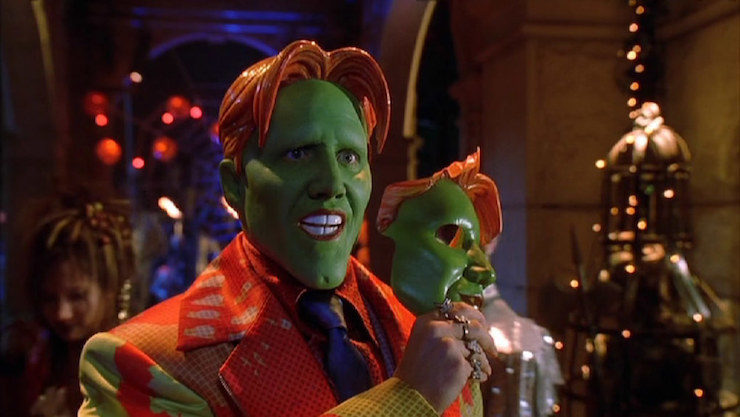
Son of the Mask
Written by Lance Khazei
Directed by Lawrence Guterman
Produced by Erica Huggins & Scott Kroopf
Original release date: February 18, 2005
Professor Neuman is giving a tour of a museum in Edge City, and he comes to the Hall of Norse Mythology, which includes the mask from the first movie. Loki is part of the tour, and he wants his mask back—except it turns out that what they have on display is a replica made in Taiwan. Loki is furious, and he attacks Neuman (removing his face and placing it in the display—Neuman blandly says he doesn’t like it there and he suffers from vertigo) and the museum guards.
The mask itself winds up washing up on the shore of a river in Fringe City, where it’s found by Otis, a dog belonging to Tim Avery and his wife Tonya. Avery works for a big animation company as a greeter in a turtle suit, but he has aspirations to be an animator himself some day. The first time he gets to pitch to the boss, it crashes and burns, but he’s encouraged to try again.
Avery attends the company Hallowe’en party, but the mask he wanted to wear was trashed by Otis, so he grabs the cheap wooden mask the dog found, ha ha. He puts it on when he arrives, and it turns his face green, his hair plastic, and he gains the usual ability to suspend all laws of physics to silly effect.
After livening up the party with a scattershot, over-the-top, spectacularly messy and confusing rendition of “Can’t Take My Eyes Off You,” he goes home and makes love to Tonya while still wearing the mask. Afterward, his boss gets an idea for a new animated series from Avery’s costume, and he gets promoted to work on it as an animator, while Tonya announces she’s pregnant. Meanwhile, Otis has buried the mask behind the house.
Because Avery was wearing the mask, the boy they have nine months later, Alvey, has all the powers of the mask without having to actually wear the fershlugginer thing. There are hints of it here and there that neither of the Averys quite notice, or only see out of the corner of their eye. (The first hint was Tonya’s morning sickness, when she barfed bubbles instead of puke.)
The same week that Avery has to work up a presentation to the network about their new show, Tonya is sent to New York for a business meeting, leaving Avery alone with Alvey.
Meanwhile, Odin is pissed off that Loki hasn’t retrieved his mask yet, and he’s even more pissed off to learn that a child has been born of the mask. He angrily sends Loki to get the damn mask back before it causes more trouble. Loki finds all the babies that were born around the same time as Alvey and checks each house under various guises (vacuum cleaner salesperson, delivery guy, plumber, etc.).
By the time he makes it to the Avery house, Avery himself is at wits’ end. Alvey has driven him insane with crying, insane behavior, literally bouncing off the walls, and peeing in four directions at once while having his diaper changed. To add insult to injury, having watched “One Froggy Evening” when Avery placed him in front of the TV to keep him occupied while he works, Alvey decides to follow the example of Michigan J. Frog, and not do any of his tricks in front of other people, whether the neighbor or Loki, which just makes Avery crazier.
Eventually, Loki figures out that Alvey is the right infant when Avery tries to take him to the doctor and he pukes green gloop all over the car. Loki chases him down, but Alvey protects his old man. Just as Loki’s about to finally grab him, Odin gets fed up with how long Loki’s taking, and removes the god’s powers.
Meanwhile, Otis—who had his own room in the house until Alvey was born, at which point he was relegated to a doghouse in the back yard—digs up the mask and puts it on. Emboldened and empowered, he tries to get revenge on Alvey, and the two have a war of looney-ness.
Avery is completely worn out at this point, and he blows the presentation to the network, which gets him fired. Loki manages to cobble together a summoning spell to explain to Odin that he found the kid, but he needs his powers to get the mask back. Odin agrees, but he only has a few hours. So Loki kidnaps Alvey, transforming the Averys’ nosy neighbor’s head into a big nose (get it??????) along the way.
Tonya returns home from her business trip to find the house trashed, her son kidnapped, and her neighbor’s head turned into a big nose. Avery manages to get the mask off Otis and they bring it to meet with Loki. Unfortunately, Loki has grown rather fond of Alvey—they’re a lot alike—and the god of mischief refuses to give the kid back. Avery puts the mask on, and another looney battle ensues before Odin’s time runs out. Odin himself shows up and disowns Loki as a failure, but then Avery actually pleads the case for Loki. Even though Alvey has driven him batshit (and cost him his job), he’s still his son and he loves him, and Odin should feel the same about Loki. Avery also gives the mask back.
Odin and Loki bugger off with the mask, Avery gets his job back by pitching an animated series about a dog and a baby who both have super-powers and fight each other, and Tonya announces that she’s pregnant again.
“Somebody stop me!”
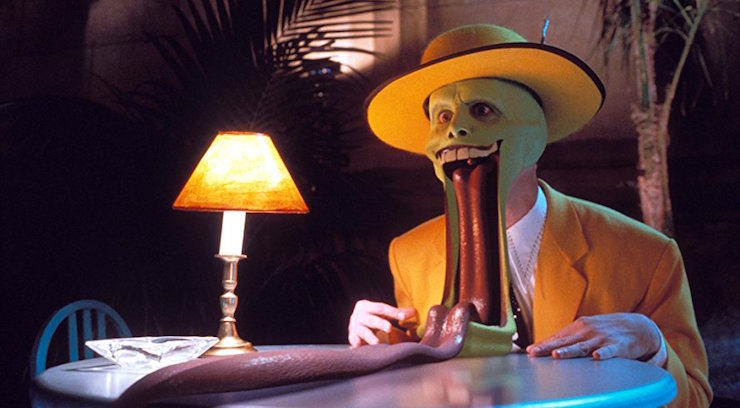
Watching these two movies back to back is a wonderful exercise in two different attempts at the same thing. In both cases, the filmmakers chose a more light-hearted approach to the source material, as The Mask in comic book form was more horror and dark humor than goofy comedy.
But one is successful, and one isn’t, because one actually remembers to tell its story well, while the other is a scattershot mess.
Both movies are doing, basically, a live-action Merrie Melodie, as the influence of Tex Avery and Chuck Jones is pretty much worn on each movie’s proverbial sleeve. (Both Ipkiss and Alvey watch the inspirational cartoons in question, just to make it obvious.) But the best animated shorts actually have a coherent plot structure, and the themes flow nicely from A to B to C. The Mask gets this, while Son is all over the damn place.
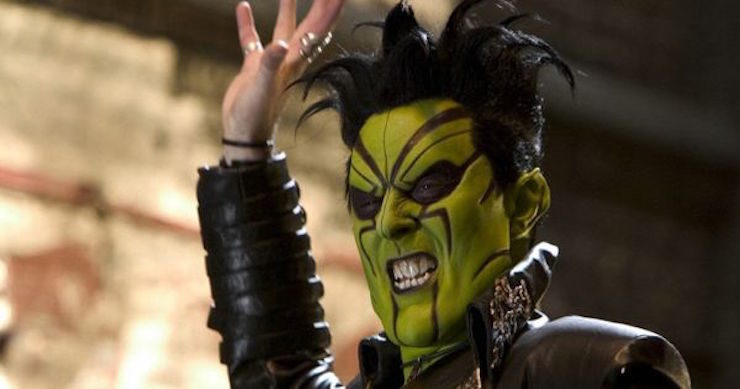
The perfect example is the first musical set piece in each. In The Mask we go from Carlyle’s slow, seductive torch song to a hoppin’ swing number. It’s a natural musical progression, and one that shows off the Mask’s lunacy, and Ipkiss’s desire for Carlyle, nicely.
By contrast, the schizophrenic rendition of “Can’t Take My Eyes Off You” is a disaster, jump-cutting to a different tone every few seconds, showing no sense of progression or sense, and just bombarding the viewer with different tempos and costumes all at once without rhyme or reason.
It doesn’t help that Jaime Kennedy is a total failure as the Mask. As the put-upon Avery, he’s adequate at best, but as the Mask, he’s a disaster. Instead of the id-let-loose that Jim Carrey does so magnificently, Kennedy just comes across as a sleazy weirdo who happens to have a green face. (It almost feels like he’s doing a really bad impersonation of Lorne from Angel.) Kennedy isn’t really built to be a leading man anyhow, as he’s much better suited to the snotty sidekick role like his iconic Scream character Randy.
Carrey is much more fun. This is the perfect role for him, combining his ability to play nebbish white guys (done to best effect in The Truman Show) with his rubber-faced lunacy. Carrey’s tendency to be over the top can get wearisome (see either of his other 1994 hits, not to mention his god-awful Riddler in Batman Forever), but each turn as the Mask is brief enough here not to wear out its welcome.
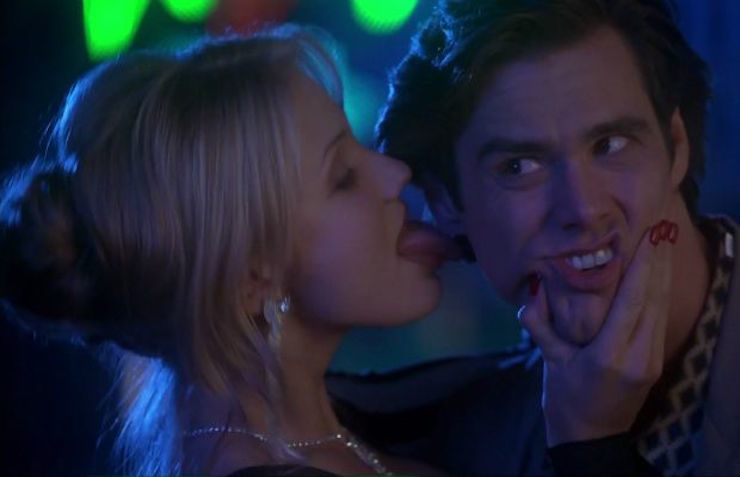
He has a mostly strong supporting cast, too. The late Richard Jeni is utterly superfluous as Schumaker, and while Peter Greene does fine as Tyrell (he’s made a career out of playing this type of gangster), his be-masked version of himself falls completely flat (you know it’s bad when the dog does a better job as the Mask than you). But everyone else is superb, from the radiant Cameron Diaz, a very strong start to her acting career (and showing her comedic skills, particularly in the dream sequence where she grabs Carrey’s head and starts lapping his ear caninely), to the delightful Amy Yasbeck to Peter Riegart, who completely steals the show as the put-upon Kellaway. Riegart’s acid commentary on the proceedings make the movie, a down-to-earth contrast to Carrey’s craziness.
Kennedy is not nearly so well supported. Traylor Howard doesn’t do anything wrong as Tonya, but her performance doesn’t particularly stand out, either. Steven Wright’s Boston monotone usually can be counted on to provide a deadpan delight, but here he just sounds like someone who can’t read his lines right, as neither script nor director takes advantage of Wright’s comic talents. Kal Penn is utterly wasted. Alan Cumming is having fun as Loki, at least, but at times he feels like he’s trying too hard. And Bob Hoskins gives what may be the worst performance of his career as Odin (let’s just say that Sir Anthony Hopkins and Ian McShane have nothing to worry about).
But the biggest problem with Son is that the bulk of the story is the zany antics of a super-powered infant, occasionally opposed by a super-powered dog. This is good fodder for a ten-minute cartoon short, but wears thin in a 94-minute movie. The Mask gave us an actual story with Ipkiss’s character progression; Son tries that with Avery’s own tribulations, but Kennedy isn’t up to the challenge, and neither is the script, which can’t maintain the right balance between plot and silliness that the first movie so deftly tap-danced through. Too much of the movie is focused on Alvey’s antics, and since it’s live action, they’re limited by the facial expressions of Liam and Ryan Falconer, the twins who play the role, and there’s only so much they can do—they’re neither of them Jim Carrey, that’s for sure. (I do like the fact that the dogs in the two movies are named Milo and Otis…)
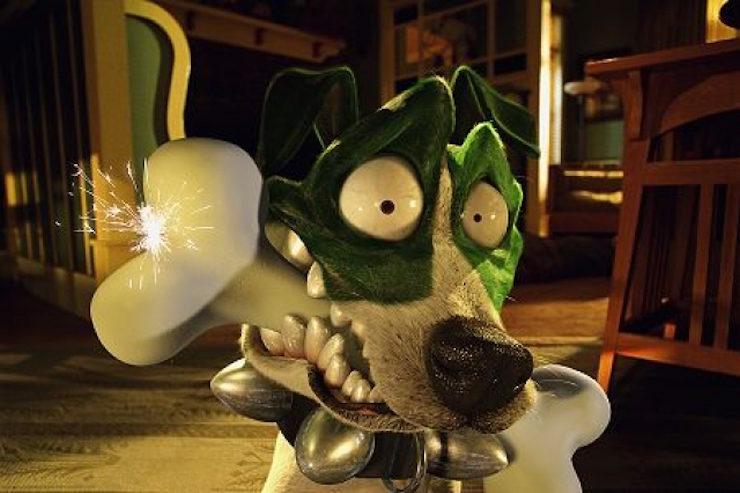
In the end, The Mask is rightly remembered as the movie that launched one excellent career (Diaz) and solidified another’s (Carrey). Son of the Mask, if it’s remembered at all, it’s as Jaime Kennedy’s sixteenth minute.
Next week, we’ll look at two teams adapted into film form, Mystery Men and The League of Extraordinary Gentlemen.
Keith R.A. DeCandido urges folks to check out his Patreon, where you can get cat photos, regular TV and movie reviews, excerpts from his upcoming fiction works, exclusive original vignettes featuring his original characters, and more niftiness.










